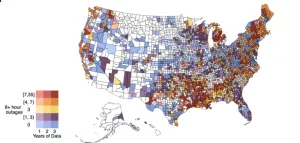(Press-News.org) In the United States, an average of three people die every day waiting for a liver transplant, which resulted in nearly 1,200 lives lost in 2021. Liver allocation policy has undergone major modifications in the last 10 years. In a new study, researchers examined these policies, finding that despite the changes, geographic inequity persists. The authors recommend a more efficient and equitable way to allocate livers.
The study, by researchers at Carnegie Mellon University (CMU) and the University of Maryland (UMD), is forthcoming in Manufacturing & Service Operations Management.
“We suggest policymakers move away from the ‘one- size-fits-all’ approach of current policy and focus on matching supply and demand to develop organ allocation policies that score well in terms of efficiency and geographic equity,” says Shubham Akshat, Assistant Professor of Operations Management at CMU’s Tepper School of Business, who led the study.
The U.S. government created the Organ Procurement and Transplantation Network (OPTN) in 1984 to coordinate a nationwide transplant system and optimize the use of limited donor organs for transplants. Since 1986, the United Network for Organ Sharing, a nonprofit private organization, has overseen the operations of OPTN. A key regulatory framework guiding organ transplantation is the Final Rule, which was adopted in 1998 by the U.S. Department of Health and Human Services and states that policies shall not be based on the candidate’s place of residence. However, disparities in organ access have been a serious issue for more than two decades. In 2012, OPTN’s board adopted a strategic plan that included reducing geographic disparities in accessing transplantation.
For the purposes of organ allocation, the United States is divided into 11 geographic regions, consisting of 58 Donation Service Areas (DSAs). A DSA-based allocation policy was in place for 30 years, from 1989 to February 2020, when it was replaced by the Acuity Circles policy, which provides a one-size-fits-all variant of broader sharing.
In the transplant community, broader organ sharing is believed to mitigate geographic inequity (e.g., inter-geographical variation in the transplant rates, patient survival rates, waiting times, offers) when considering access to organs. In this study, researchers developed a model based on about 40 medical characteristics of patients and donors to analyze allocation policies that differ from current and proposed policies, and to determine whether a better alternative exists.
The model accurately predicts the change in a patient’s organ-offer acceptance probability due to a change in policy. They used data from the Scientific Registry of Transplant Recipients, which includes information on all donors, wait-listed candidates as well as U.S. transplant recipients.
Based on their model’s predictions, the researchers conclude that broader sharing in its current form (i.e., as part of Acuity Circles) may not be the best strategy to balance geographic equity and efficiency. Instead, they suggest that a policy that equalizes the ratio of deceased donors to waiting list patients across geographic regions would work better in achieving geographic equity at the lowest tradeoff in efficiency.
“Recent policies are moving toward broader sharing in principle, but the current Acuity Circles policy leads to even lower efficiency,” explains S. Raghavan, Professor of Management Science and Operations Management at UMD, who coauthored the study. “A customized approach involving equalizing the supply-to-demand ratios across the geographic regions of the country is a better option.”
“Our model can be used to provide more accurate policy evaluations to decision makers,” says Liye Ma, Associate Professor of Marketing at UMD, who coauthored the study.
END
In US system of allocating livers for transplanting, geographic inequity persists despite recent policy changes
study suggests approach that equalizes supply-to-demand ratios across regions
2023-05-01
ELSE PRESS RELEASES FROM THIS DATE:
Prolonged power outages, often caused by weather events, hit some parts of the U.S. harder than others
2023-05-01
Joan Casey lived through frequent wildfire-season power outages when she lived in northern California. While waiting for the power to return, she wondered how the multi-day blackouts affected a community’s health.
“For me it was an inconvenience, but for some people it could be life-threatening,” said Casey, now an assistant professor in the University of Washington’s Department of Environmental and Occupational Health Sciences. “If you had an uncle that ...
Columbia University study finds that improved access to mental health care is associated with reductions in suicide risk
2023-05-01
Amid historically high suicide rates and mental health care provider shortages, new research from Incite @ Columbia University suggests that interventions to alleviate mental health care access disparities can prevent unnecessary death and suffering. In an article pending publication in PNAS next week, “Differential Spatial-Social Accessiblity to Mental Health Care and Suicide," Daniel Tadmon and Peter S. Bearman find that in the United States improved access to mental health care is associated with reductions in suicide risk.
To enable this research, Tadmon and Bearman developed new methods of measuring access ...
Chances of eliminating HIV infection increased by novel dual gene-editing approach
2023-05-01
EMBARGO UNTIL: May 1, 2023 at 3 PM ET
Gene-editing therapy aimed at two targets – HIV-1, the virus that causes AIDS, and CCR5, the co-receptor that helps the virus get into cells – can effectively eliminate HIV infection, new research from the Lewis Katz School of Medicine at Temple University and the University of Nebraska Medical Center (UNMC) shows. The study, published online in the journal The Proceedings of the National Academy of Sciences (PNAS), is the first to combine a dual gene-editing strategy with antiretroviral ...
Scientists discover anatomical changes in the brains of the newly sighted
2023-05-01
CAMBRIDGE, MA — For many decades, neuroscientists believed there was a “critical period” in which the brain could learn to make sense of visual input, and that this window closed around the age of 6 or 7.
Recent work from MIT Professor Pawan Sinha has shown that the picture is more nuanced than that. In many studies of children in India who had surgery to remove congenital cataracts beyond the age of 7, he has found that older children can learn visual tasks such as recognizing ...
NYU Abu Dhabi study identifies brain structures that underlie sight recovery in blind teenagers
2023-05-01
Fast facts:
Congenital cataracts are the leading cause of treatable blindness in children worldwide. In nations where the surgery is widely available, surgery occurs during infancy and there is a good prognosis for the recovery of visual function.
It is widely accepted that the window for surgical intervention for congenital cataracts closes by the time a child reaches the ages of six to eight years old, as that is a critical period for visual brain development. Restoration of the visual input later in life is generally ...
Evidence of conscious-like activity in the dying brain
2023-05-01
[EMBARGOED UNTIL May 1, 2023 at 3:00 PM U.S. Eastern time]
Reports of near-death experiences--with tales of white light, visits from departed loved ones, hearing voices, among other attributes—capture our imagination and are deeply engrained in our cultural landscape.
The fact that these reports share so many common elements begs the question of whether there is something fundamentally real underpinning them—and that those who have managed to survive death are providing glimpses of a consciousness that does not completely disappear, even after the heart stops ...
50-year study offers insight into effects of climate on bird reproduction
2023-05-01
CHAMPAIGN, Ill. — A new study reported in the Proceedings of the National Academy of Sciences assessed changes in the reproductive output of 104 bird species around the world between 1970 and 2019. The study reveals that a warming climate appears to have more worrisome effects on larger birds and migratory birds than on smaller, sedentary species.
Study co-author Jeffrey Hoover, an avian ecologist at the Illinois Natural History Survey describes the findings in an interview with University of Illinois Urbana-Champaign life sciences editor Diana Yates.
Some highlights:
Increasing local temperatures during the chick-rearing part of the ...
Coal trains increase air pollution in San Francisco bay area
2023-05-01
Coal trains and terminal operations add a significant amount of fine particulate matter (PM2.5) pollution to urban areas, more so than other freight or passenger trains, according to a study conducted in Richmond, California, by the University of California, Davis.
The paper, published in the journal Air Quality, Atmosphere & Health, is the first study of coal train particulate pollution in a U.S. urban area. It’s also the first to use artificial intelligence technologies to verify that the source of air pollution detected comes from coal.
It found that passing trains carrying ...
Silver nanoparticles spark key advance in thermoelectricity for power generation
2023-05-01
HOUSTON – Several high-performance thermoelectric materials have been discovered over the past two decades, but without efficient devices to convert the energy they produce into emission-free power, their promise has been unfulfilled. Now an international team of scientists led by a University of Houston physicist and several of his former students has reported a new approach to constructing the thermoelectric modules, using silver nanoparticles to connect the modules’ electrode and metallization layers.
The ...
A new method to test cancer drug toxicity
2023-05-01
For people with cancer, chemotherapy saves lives, but for some patients, the treatment comes with a side effect—heart damage. Screening cancer drugs for cardiotoxicity has been an ongoing challenge as heart cells don’t naturally grow in a dish, requiring researchers to do this critical testing using cardiac tissue from rodent models. A new study from researchers at Cummings School of Veterinary Medicine at Tufts University and Tufts Medical Center reports that heart tissue obtained through organ donations from dogs dying of other causes are a promising platform for testing cancer drug toxicity, offering scientists a new alternative.
The ...
LAST 30 PRESS RELEASES:
Insilico Medicine and Taigen achieves license agreement to develop and commercialize AI-driven PHD inhibitor for anemia of Chronic Kidney Disease (CKD)
Exploring dominant endophytic Pleosporales in grasses: New taxonomic insights in the suborder Massarineae
Comparative transcriptomic analysis of human maxillary and mandibular tooth germs reveals discrepancies in gene expression patterns
Scientists detect atmosphere on molten rocky exoplanet - study
Chip-scale magnetometer uses light for high-precision magnetic sensing
Illinois Tech biomedical engineering professor Philip R. Troyk elected as Fellow of the National Academy of Inventors
The National Academy of Inventors welcomes 2025 Class of Fellows
Multi-scale modelling framework predicts mechanical responses of Fe–Cr–Al alloys across composition and processing conditions
Preoperative radiation may improve antitumor immune response in most common form of breast cancer
Breast MRI may be safely omitted from diagnostic workup in certain patients with early-stage, HR-negative breast cancer
Sentinel lymph node biopsy may be safely omitted in some patients with early-stage breast cancer
Rats may seek cannabis to cope with stress
New FAU research strengthens evidence linking alcohol use to cancer
Gut health à la CAR T
Dr. Pengfei Liu receives 2026 O'Donnell Award in Medicine for pioneering advances in genetic diagnostics and rare disease treatment
Dr. Yunsun Nam receives 2026 O'Donnell Award in Biological Sciences for pioneering RNA research transforming gene regulation and cancer therapy
Dr. Bilal Akin wins 2026 O'Donnell Award in Engineering for transformative work in EV energy systems and industrial automation
Dr. Fan Zhang receives 2026 O'Donnell Award in Physical Sciences for groundbreaking discoveries in quantum matter and topological physics
Dr. Yue Hu receives 2026 O'Donnell Award for revolutionizing energy operations with real-time AI and reinforcement learning
Greater risk that the political right falls for conspiracy theories
JMC Publication: Insilico’s AI platforms enable discovery of potent, selective, oral DGKα inhibitor to overcome checkpoint resistance
Targeting collagen signaling boosts drug delivery in pancreatic cancer
Valvular heart disease is common in cancer patients but interventions improve survival
When socially responsible investing backfires
Cuffless blood pressure technologies in wearable devices show promise to transform care
AI-based tool predicts future cardiovascular events in patients with angina
Researchers map how the cerebellum builds its connections with the rest of the brain during early development
Routine scans could detect early prostate radiotherapy changes
Fairness in AI: Study shows central role of human decision-making
Pandemic ‘beneath the surface’ has been quietly wiping out sea urchins around the world
[Press-News.org] In US system of allocating livers for transplanting, geographic inequity persists despite recent policy changesstudy suggests approach that equalizes supply-to-demand ratios across regions





